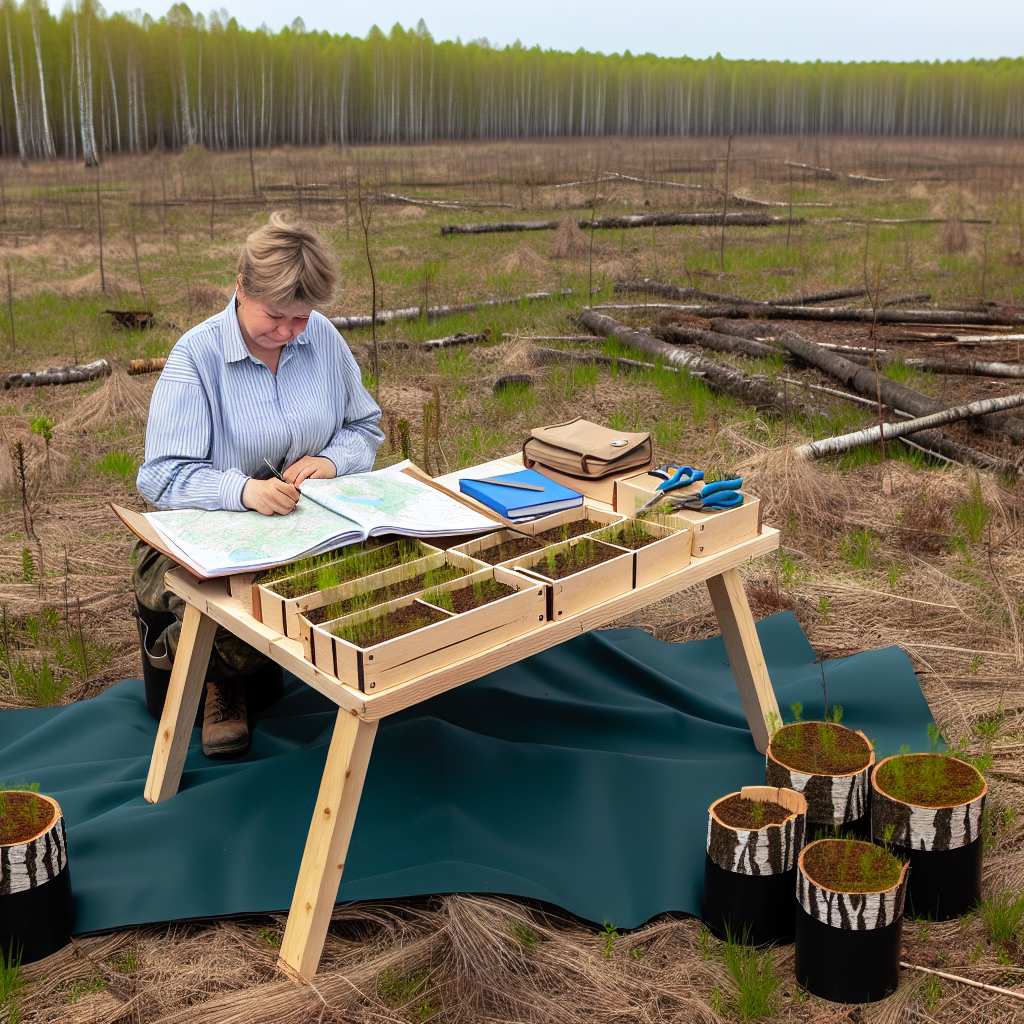Overview of Agroforestry and Its Role in Land Development
Understanding Agroforestry
Agroforestry integrates trees and shrubs into agricultural landscapes.
It enhances biodiversity and improves soil health.
This practice offers numerous environmental benefits.
Furthermore, it provides habitat for various wildlife species.
Benefits of Agroforestry in Land Development
Agroforestry systems contribute significantly to land sustainability.
They help in soil conservation and reduce erosion.
Additionally, these systems enhance water retention in the soil.
This allows for a more efficient use of resources.
Enhancing Wildlife Habitats
Agroforestry creates diverse environments ideal for wildlife.
It provides food and shelter for many species.
This diversity supports ecological balance within landscapes.
Moreover, it encourages natural pest control through predation.
Agroforestry and Climate Resilience
Agroforestry plays a crucial role in combating climate change.
It acts as a carbon sink, sequestering atmospheric carbon.
This practice can help mitigate the impacts of extreme weather.
Transform Your Agribusiness
Unlock your farm's potential with expert advice tailored to your needs. Get actionable steps that drive real results.
Get StartedConsequently, it fosters ecosystem resilience.
Economic Advantages for Land Developers
Integrating agroforestry can enhance property value.
It offers additional income streams from timber or fruits.
This approach attracts environmentally conscious investors.
Ultimately, it supports sustainable economic development.
Benefits of Agroforestry for Wildlife Habitat Enhancement
Improved Biodiversity
Agroforestry supports a diverse range of habitats.
This approach fosters various species living together.
Planting trees and shrubs attracts insects and birds.
Consequently, it increases the overall biodiversity of the area.
Increased Food Resources
Agroforestry provides ample food for wildlife.
Fruits, nuts, and seeds from diverse plants are readily available.
These resources are crucial for various species, including mammals and birds.
Additionally, such food sources enhance species survival rates.
Improved Soil Health
Healthy soil supports thriving ecosystems.
Agroforestry practices improve soil structure and fertility.
Moreover, diverse root systems help prevent erosion.
This creates a stable environment for other organisms.
Microclimate Creation
Agroforestry practices create beneficial microclimates.
Shaded areas help reduce extreme temperatures.
This environment is crucial for body temperature regulation in wildlife.
Moreover, humidity levels remain more stable around vegetation.
Water Management
Agroforestry supports efficient water management.
Tree roots help with water infiltration into the soil.
Consequently, this reduces surface runoff and erosion.
Showcase Your Farming Business
Publish your professional farming services profile on our blog for a one-time fee of $200 and reach a dedicated audience of farmers and agribusiness owners.
Publish Your ProfileHealthy soil retains water better, promoting wildlife habitats.
Enhanced Connectivity
Agroforestry creates corridors for wildlife movement.
These corridors allow animals to move safely between habitats.
It reduces fragmentation caused by agriculture and development.
Consequently, enhanced connectivity supports genetic diversity.
Support for Pollinators
Agroforestry systems are beneficial for pollinators.
Wildflower patches attract bees and butterflies.
Moreover, diversified crops provide continuous bloom periods.
This encourages pollinator populations to thrive.
Key Agroforestry Practices to Implement for Wildlife Conservation
Integrating Trees into Crop Systems
Integrating trees into crop systems creates diverse habitats for wildlife.
This practice allows crops and trees to coexist.
It promotes ecological benefits.
It enhances soil fertility and improves water retention.
Furthermore, it provides shade and shelter for various species.
Creating Wildlife Corridors
Wildlife corridors connect fragmented habitats.
They enable safe species movement.
By planting native vegetation along these corridors, animals can find shelter.
These passages reduce human-wildlife conflicts.
They increase biodiversity.
In addition, they promote genetic exchange between isolated populations.
Implementing Agroforestry Systems
Agroforestry systems combine agriculture and forestry for mutual benefit.
They support diverse plant and animal communities.
These systems increase yields.
This approach enhances landscape resilience to climate change impacts.
Moreover, it can improve carbon sequestration and air quality.
Utilizing Cover Crops for Soil Health
Cover crops enhance soil health and prevent erosion.
By improving nutrient cycling, they contribute to sustainable farming practices.
They also provide habitat for beneficial insects and wildlife.
Utilizing diverse cover crops can further enhance biodiversity.
Promoting Organic Practices
Organic practices reduce synthetic chemical usage.
These methods benefit wildlife populations.
They enhance soil health and promote natural pest control.
By supporting local ecosystems, organic farming improves species diversity.
Additionally, it fosters a healthier environment for future generations.
Explore Further: Smart Irrigation Strategies for Efficient Water Use in Agriculture
Case Studies: Successful Integration of Agroforestry in Different Regions
African Agroforestry Initiatives
African countries have embraced agroforestry to combat land degradation.
In Kenya, the Green Belt Movement has promoted tree planting alongside crops.
This initiative has enhanced food security while restoring ecosystems.
Farmers benefit from increased yields and improved soil fertility.
Moreover, these efforts support local wildlife habitats effectively.
Showcase Your Farming Business
Publish your professional farming services profile on our blog for a one-time fee of $200 and reach a dedicated audience of farmers and agribusiness owners.
Publish Your ProfileAsian Agroforestry Strategies
In India, agroforestry practices have flourished in rural communities.
Farmers cultivate fruit trees alongside cash crops, diversifying their income.
This model mitigates climate impacts and improves resilience against drought.
Additionally, this integration fosters biodiversity and wildlife protection.
Organizations like the World Agroforestry Centre provide valuable training.
European Agroforestry Models
European nations explore agroforestry as part of sustainable land management.
France has implemented policies supporting agroforestry on agricultural land.
Research indicates that tree planting enhances carbon sequestration significantly.
Farmers report greater pest control and improved crop health from trees.
Overall, these practices create harmonious ecosystems and agricultural landscapes.
North American Agroforestry Practices
In the United States, agroforestry is gaining traction among farmers.
The USDA has launched programs promoting silvopasture and alley cropping.
These systems optimize land use while providing habitat for wildlife.
Furthermore, farmers experience reduced risk from climate variability.
Collaborative projects focus on educating communities about agroforestry benefits.
Explore Further: Maximizing Farmland ROI With Climate-Resilient Agriculture
Challenges in Combining Agriculture and Forestry for Habitat Improvement
Understanding the Dual Focus
Agroforestry merges agricultural and forestry practices effectively.
However, this integration faces numerous challenges.
Both sectors have different objectives and practices.
Farmers often prioritize crop yields over biodiversity.
Conversely, foresters focus on long-term forest health.
Competition for Resources
One major challenge is resource competition.
Crops and trees compete for water, nutrients, and light.
This competition can reduce overall productivity.
It complicates the management of both systems.
Management Complexity
Agroforestry requires advanced management techniques.
Farmers must balance tree growth and crop productivity.
Such complexity may discourage participation in agroforestry.
Specialized knowledge is crucial for successful integration.
Economic Viability
Economic considerations often dictate land use decisions.
Short-term agricultural gains may overshadow long-term benefits.
Investments in agroforestry can present financial risks.
Additionally, markets for timber and other forest products may fluctuate.
Policy and Regulatory Hurdles
Existing policies may not support agroforestry initiatives.
Regulations can exacerbate the difficulties in implementation.
Moreover, land tenure issues can hinder investment and commitment.
Policies must evolve to encourage sustainable practices.
Climate Change and Environmental Impact
Climate change poses a significant threat to agroforestry.
Changing weather patterns can affect crop and tree health.
Moreover, environmental stress can complicate habitat improvement efforts.
Showcase Your Farming Business
Publish your professional farming services profile on our blog for a one-time fee of $200 and reach a dedicated audience of farmers and agribusiness owners.
Publish Your ProfileResilience strategies are necessary to adapt to these changes.
Educational Gaps
A lack of awareness exists regarding agroforestry benefits.
Farmers and landowners may lack access to training.
Educational programs can improve understanding and implementation.
Collaboration between experts and local communities is vital.
Uncover the Details: Drought and Flood Risks for Agricultural Real Estate Investors

The Role of Native Plants in Agroforestry Systems for Wildlife
Understanding Native Plants
Native plants are species that naturally occur in a specific region.
They have adapted to local environmental conditions over time.
Moreover, they play a crucial role in local ecosystems.
Benefits of Native Plants in Agroforestry
Utilizing native plants enhances biodiversity dramatically.
These plants provide food and shelter for various wildlife species.
Additionally, they help to stabilize soil and prevent erosion.
Native plants also support pollinators, crucial for crop production.
Creating Habitat Corridors
Agroforestry can create habitat corridors for wildlife movement.
These corridors link fragmented habitats and promote genetic diversity.
Ultimately, they allow wildlife to thrive in agricultural landscapes.
Improving Soil Health
Native plants improve soil quality through extensive root systems.
They contribute organic matter and enhance nutrient cycling.
As a result, healthier soils can support more diverse plant life.
Climate Resilience
Native plants are often more resilient to climate variations.
They require fewer resources, such as water and fertilizer.
Consequently, they contribute to sustainable land management practices.
Examples of Native Plant Integration
Several organizations are successfully integrating native plants.
The Land Stewardship Foundation promotes the use of native species.
Additionally, the Native Plant Alliance highlights their ecological benefits.
- Examples of native plant use in agroforestry systems:
- Prairie grasses in Midwest farming regions.
- Southern California sage scrub for erosion control.
- Northern tallgrass prairie plants enhancing soil health.
Explore Further: The Impact of Climate Change on Irrigation and Sustainable Farming
Assessing Biodiversity Improvement Through Agroforestry Practices
Understanding Agroforestry
Agroforestry combines agriculture and forestry practices.
This integration creates diverse ecosystems on agricultural land.
It enhances both productivity and biodiversity.
Measuring Biodiversity
Biodiversity assessment is crucial in agroforestry.
It involves evaluating various species and ecosystems.
Researchers often use metrics like species richness and abundance.
This data helps to understand ecological health.
Benefits of Agroforestry for Wildlife
Agroforestry offers numerous advantages for wildlife habitats.
It creates shelter and food sources for various species.
Dense plantings can reduce habitat fragmentation.
This allows for better movement and interactions among animals.
Implementing Effective Practices
- Planting trees alongside crops enhances soil quality.
- Creating windbreaks provides protection against harsh winds.
- Maintaining riparian buffers improves water quality.
Each practice contributes positively to local biodiversity.
Research Case Studies
Numerous studies demonstrate agroforestry’s success in increasing biodiversity.
For instance, a study in Brazil highlighted increased bird populations.
Showcase Your Farming Business
Publish your professional farming services profile on our blog for a one-time fee of $200 and reach a dedicated audience of farmers and agribusiness owners.
Publish Your ProfileAnother research in Kenya showed improved insect diversity.
These results showcase the positive impact on wildlife habitats.
Challenges and Considerations
Implementing agroforestry is not without challenges.
Farmers may face initial costs and labor requirements.
Additionally, selecting appropriate tree species is critical.
Localized knowledge can help mitigate these issues.
Future Directions in Agroforestry Biodiversity
Enhancing biodiversity through agroforestry remains a priority.
Future efforts should focus on research and education.
Encouraging community participation could drive successful projects.
Ultimately, agroforestry can significantly benefit wildlife habitats.
Future Trends in Agroforestry and Wildlife Conservation Strategies
Integrating Modern Technology
Modern technology will play a crucial role in agroforestry’s future.
Precision agriculture can enhance land management practices.
Drones will monitor wildlife habitats efficiently and provide real-time data.
Data analytics will optimize crop yields while supporting biodiversity.
Enhancing Biodiversity through Plant Selection
Future agroforestry practices will emphasize diverse plant selections.
By using native species, farmers can improve local ecosystems.
This approach encourages a variety of wildlife to thrive.
Companion planting will enhance crop resilience against pests.
Collaborative Conservation Efforts
Collaboration will be essential among farmers, conservationists, and governments.
Public-private partnerships will support sustainable land use initiatives.
These efforts will raise awareness and improve habitat protection strategies.
Education will empower local communities to participate actively.
Policy Advancements and Support Mechanisms
Governments will likely introduce supportive policies for agroforestry.
Incentives will encourage landowners to adopt sustainable practices.
Offering tax breaks and grants can motivate greater participation.
Stronger regulations will protect vital wildlife habitats.
Climate Change Mitigation Strategies
Agroforestry will play a vital role in combating climate change.
By sequestering carbon, agroforestry systems can help reduce greenhouse gases.
Regenerative practices will restore soil health and enhance resilience.
Transitioning to agroecological farming methods will promote sustainability.
Additional Resources
Impact of Sustainable Agriculture and Farming Practices
Conservation Innovation Grants Awards Fiscal Year 2023 | Natural …




